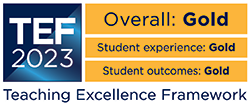Teesside is a top performer for widening participation
Teesside is one of the top universities in the country for opening its doors to less well-off students for the third year running.
The welcome news, confirmed today (19 December, 2001) in the Higher Education Funding Council for England Performance Indicators, is a major boost for Teesside’s mission to be the Opportunity University.
The Performance Indicators were introduced three years ago by the Funding Council to monitor the make-up of the higher education student population, with benchmarks set for each university based on courses on offer and the current student mix.
The University of Teesside is at the forefront of working with schools in areas where fewer-than-average young people go on to higher education, with its high-profile initiatives such as the Meteor Programme winning awards and praise from Government ministers. Its part-time courses in the community are also helping to make university life more attractive to the next generation of both young and old students.
Professor Derek Fraser, the University’s Vice-Chancellor, said: “Teesside has met or exceeded all its benchmarks for attracting under-represented entrants. These include mature students and students from state schools as well as entrants from Social Classes 3, 4 & 5 and people from neighbourhoods with lower-than-average participation rates in higher education.
“The percentage of young working class students on full-time courses is particularly notable, up from 38% to 45% in two years,” said Professor Fraser. Mature student numbers are also holding-up well at Teesside, at 33%, while nationally they are in decline. Only Wolverhampton University was able to match or better Teesside’s percentage of young working class students and only Sunderland achieved a higher percentage of young student entrants from low participation neighbourhoods.
Professor Fraser, said: “The University of Teesside performs well against the benchmarks calculated by the Funding Council. This is very encouraging and we believe the figures demonstrate that we are achieving our mission of being the Opportunity University and helping to widen participation in higher education to an ever-broadening range of students.”
The benchmarks relate to similar students across the University sector as defined by subject studied and their entry qualifications.
 Supporting Nigerian farmers by transforming food waste into
...
Supporting Nigerian farmers by transforming food waste into
... International partnership signed with prestigious American
...
International partnership signed with prestigious American
... Teesside University academics join prestigious network of
...
Teesside University academics join prestigious network of
...